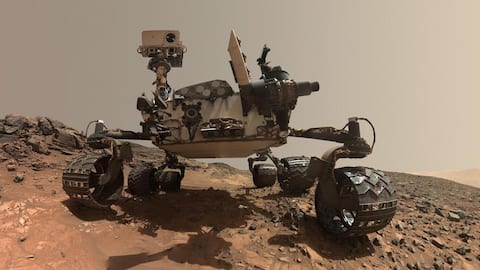NASA's Curiosity arrives at Martian ridge formed during 'wet period'
What's the story
NASA's Curiosity rover has successfully reached a rather intriguing location on Mars, called Gediz Vallis Ridge, which may contain crucial information about the planet's watery past. The rover has captured a stunning 360-degree panoramic view of the ridge, that is theorized to have formed from violent debris flows, that were later eroded by wind into a towering formation. Interestingly, this event took place about 3 billion years ago during one of the last wet periods on Mars.
Details
Gediz Vallis Ridge is a 'geological time capsule'
The Gediz Vallis Ridge is one of the last features to form on Mount Sharp, a 5-kilometer-tall mountain that Curiosity has been ascending since 2014. This makes it one of the "youngest geological time capsules Curiosity will see." Different layers of the mountain represent different eras of Martian history, per NASA. Dark rocks in the panoramic view captured by Curiosity likely originated from elsewhere, offering a rare glimpse at material from the upper part of the mountain.
Journey
Curiosity's challenging journey to Gediz Vallis Ridge
Reaching the Gediz Vallis Ridge, however, was no easy feat for Curiosity, as the rover had to navigate through knife-edged "gator-back" rocks and steep slopes. After three attempts, Curiosity finally arrived at the ridge on August 14, capturing the panoramic mosaic with its 7-foot robotic arm. This achievement also provided scientists with the first up-close views of the eroded remnants of a geologic feature called debris flow fan, where debris flowing down the slope spreads out into a fan shape.
Ridge
Debris flow fans are present on both Mars and Earth
Debris flow fans are present on both Mars and Earth, but scientists are still learning how they came into being. "Huge rocks were ripped out of the mountain high above, rushed downhill, and spread out into a fan below," said geologist William Dietrich, who helped lead Curiosity's study of the ridge. "The results of this campaign will push us to better explain such events not just on Mars, but even on Earth, where they are a natural hazard."
Insights
What is Curiosity going to do next?
"It's a thrill to be able to reach out and touch rocks that were transported from places high up on Mount Sharp that we'll never be able to visit with Curiosity," said Ashwin Vasavada, Curiosity's project scientist. While scientists are still analyzing the data from the ridge, Curiosity has moved to the next challenge. It now has to find a path to the channel above the ridge to shed light on how and where water once flowed down Mount Sharp.
